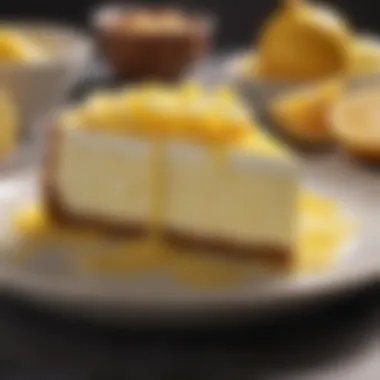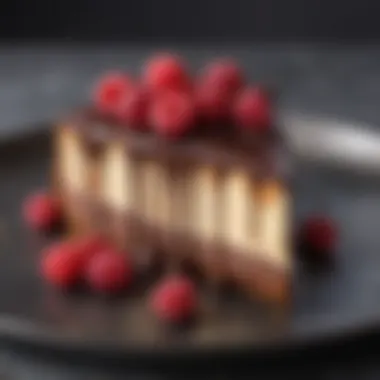Exploring Unique Summer Cheesecake Flavors


Intro
Summer offers a unique opportunity to explore light and refreshing dessert options. Among these, cheesecake shines brightly for its versatility and flavor potential. Each year, just as the sun's rays illuminate our gardens, new inspirations arise for creating delightful cheesecake varieties that capture the essence of the season. This guide strives to navigate through a myriad of flavors and techniques that can embrace the warmth of summer while keeping desserts vibrant and satisfying.
Delving deeper into the realm of cheesecake, we find both classic and innovative recipes that utilize seasonal ingredients. These might include fruity toppings, herbal infusions, and experimental flavor combinations that elevate this traditional dessert. As the culinary landscape evolves, so does the cheesecake. New trends interlace traditional recipes with fresh ideas that beckon both seasoned chefs and home cooks.
In the following sections, we will explore a selection of summer cheesecake flavors, laying out ingredient lists essential for their preparation and discussing potential substitutions. Whether you are a novice exploring the sweet art of cheesecakes or a seasoned professional refining your craft, this article aims to provide insightful guidance based on the latest culinary practices.
Prolusion to Summer Cheesecake
Summer cheesecake represents a delightful intersection of creamy textures and refreshing flavors. As the temperature rises, a traditional dense cheesecake might not always hit the spot. Instead, lighter, fruit-infused variations become more appealing, offering a sweet treat without an overwhelming richness. This article explores the various facets of summer cheesecake, focusing on both classic and innovative flavors that enhance your dessert repertoire.
Incorporating seasonal ingredients is vital for maximizing taste and freshness. Fruits like strawberries, blueberries, lemons, and peaches not only add vibrant flavor profiles but also elevate the visual presentation of the dessert. Understanding the essence of these ingredients encourages creative culinary experimentation, making summer cheesecake a canvas for both novice and experienced chefs alike.
The significance of adopting different flavor combinations cannot be overstated. Pairing fruits with herbs or even integrating spices can lead to unexpected yet delightful outcomes. A well-crafted summer cheesecake can act as a conversation starter, captivating diners with its intricate taste layers.
Moreover, the health-conscious aspect of summer cheesecakes is gaining prominence. As more individuals seek lighter alternatives, exploring reduced sugar, vegan, and gluten-free options offers inclusivity. It allows everyone to revel in the joy of cheesecake, regardless of dietary restrictions.
"Summer cheesecake embodies the spirit of the season, combining freshness with creativity."
Ultimately, summer cheesecake is more than a dessert. It represents a culinary experience that encapsulates warmth, lightness, and the vibrant bounty of summer. This exploration will illuminate the flavors, preparation techniques, and ingredient considerations that define this beloved sweet treat.
The Foundation of Cheesecake
The foundation of cheesecake is crucial for achieving the right texture and flavor. Cheesecake's base consists of essential components that contribute to its rich and creamy nature. Understanding these foundational elements allows cooks to experiment effectively and create desirable variations suitable for summer.
Essential Ingredients
Cheese Varieties
Cheese is the pivotal ingredient in cheesecake. The most common types used include cream cheese, ricotta, and mascarpone. Cream cheese is popular for its smooth texture and tangy flavor, making it a staple for traditional recipes. Ricotta, with its lighter consistency, brings a subtle flavor that is ideal for lighter summer desserts.
One advantage of cream cheese is its availability, and it's often less expensive than other cheese varieties. However, using ricotta can result in a fluffier texture. When choosing cheese, consider the flavor profile you want to achieve. A rich and dense cheesecake often requires cream cheese, while a light, airy result may benefit from ricotta.
Sweeteners
Sweeteners play a critical role in balancing the tanginess of the cheese. Granulated sugar is commonly used, but alternatives like honey, agave nectar, or maple syrup can enhance flavor while providing unique notes.
The key characteristic of sweeteners is how they complement the cheesecake's overall flavor. For instance, honey adds a floral note, while agave nectar delivers a smooth sweetness. Sugars dissolve well in the batter, ensuring even sweetness throughout. One must consider that non-traditional sweeteners may alter the taste, but they often support healthier options for those monitoring sugar intake.
Crust Components
The crust is another essential aspect of cheesecake. Traditional crusts consist of crushed graham crackers mixed with butter. Some variations use digestive biscuits or cookies, providing diversity in flavor and texture.
The primary benefit of a well-made crust is its ability to balance the creamy filling. A crumbly texture contrasts beautifully with the dense filling. Using flavored cookies can elevate the experience further; however, it can complicate the flavor balance. It’s essential to press the crust firmly to ensure it holds together when sliced.
Preparation Techniques
Mixing Methods
Mixing methods are vital for integrating ingredients smoothly. The first step typically involves blending the cream cheese until it's soft and creamy. Incorporating other ingredients gradually helps prevent lumps.
A common method includes using an electric mixer, which allows for a consistent texture and eliminates air pockets. However, a handheld whisk can deliver satisfactory results if you're inclined for a more hands-on approach. Mixing too vigorously, though, may incorporate too much air, resulting in cracks during baking.


Baking vs. No-Bake Options
When deciding between baking and no-bake methods, consider the desired texture and flavor. Baked cheesecakes have a rich density and typically set beautifully, while no-bake versions are lighter and creamier.
Baking involves a water bath to stabilize temperature and moisture levels, reducing the risk of cracking. No-bake versions are often quicker to prepare and require chilling but will not have the same depth of flavor as their baked counterparts. Each method has its advantages, so it often comes down to personal preference and time constraints.
Setting and Chilling
The setting and chilling stage is critical for developing flavor and texture in cheesecake. Once prepared, cheesecakes need time in the refrigerator, which allows them to firm up and the flavors to meld.
Typically, a minimum of four hours is advised, but overnight chilling provides the best results. The unique feature of this process is how it affects the structure of the cheesecake. Adequate chilling eliminates any residual moisture and enhances the final presentation by ensuring clean cuts when served.
When preparing summer cheesecakes, consideration of these foundational elements leads to optimal flavor and texture. By selecting the right cheese, sweeteners, and crust components, as well as employing effective preparation techniques, anyone can master the art of crafting delightful cheesecakes suitable for hot weather.
Traditional Summer Flavors
The section on Traditional Summer Flavors holds significant importance as it encapsulates the essence of summer within the context of cheesecake. Seasonal flavors like lemon, strawberry, and blueberry evoke nostalgic memories and capture the vibrancy of summer produce. These flavors not only bring freshness, but also enhance the appeal of cheesecakes, making them perfect for warm weather gatherings and celebrations. Understanding these traditional flavors allows bakers to craft recipes that resonate with both classic preferences and contemporary palate trends.
Classic Lemon Cheesecake
Classic Lemon Cheesecake embodies the bright and zesty characteristics of lemons, which symbolize summer. The tangy flavor serves to cut through the rich creaminess of the cheese, creating a well-balanced dessert. To achieve a successful lemon cheesecake, using freshly squeezed lemon juice is crucial. It not only infuses the cheesecake with vibrant flavor but also contributes to a more aromatic profile. The addition of lemon zest enhances this cake, offering an extra depth of citrusy aroma and taste.
A common practice is to create a buttery graham cracker crust, which complements the sharpness of the lemon filling beautifully. Baking the cheesecake in a water bath can prevent cracks and ensures a smooth surface. For presentation, consider garnishing with fresh lemon slices or a light dusting of powdered sugar to enhance visual appeal.
Strawberry Swirl Cheesecake
Strawberry Swirl Cheesecake is a celebration of the duality of flavors, combining the creamy nature of cheesecake with the sweetness of fresh strawberries. The vibrant color of the strawberries creates an inviting appearance, making this dessert a visual treat. The preparation involves incorporating a strawberry puree into the cheesecake batter, creating delicate swirls that are both aesthetic and flavorful.
Selecting ripe strawberries is key to obtaining the best flavor. They should be blended to form a smooth puree, and then swirled into the cheesecake mixture just before baking. This cheesecake pairs well with a variety of crusts, though a classic graham cracker crust often gives a pleasing contrast to the fruit. For serving, a few fresh strawberries on top add a nice touch, balancing out the rich and creamy texture of the cheesecake.
Blueberry Cheesecake
Blueberry Cheesecake is another classic dessert that showcases the beautiful flavor of fresh blueberries. Blueberries impart a natural sweetness, along with a mildly tart taste that complements the richness of the cheesecake. Similar to the strawberry version, blueberry compote can be used either mixed into the batter or swirled on top before baking.
Using both fresh and concentrated blueberry flavors can deepen the taste experience. Fresh blueberries can be folded into the batter, while a blueberry sauce can be drizzled over the top as a finishing touch. The crust can be the same buttery graham cracker one or can experiment with a nut-based crust for added texture. This cheesecake is not only popular but also resonates well in summer gatherings where light, fruit-forward desserts are favored.
"Embracing traditional flavors in cheesecake not only celebrates summer but also elevates the overall dessert experience."
Through engaging with these Traditional Summer Flavors, bakers can enrich their culinary repertoire. Additionally, these flavors invite creativity and experimentation, allowing one to honor the essence of summer desserts while also catering to contemporary tastes.
Innovative Cheesecake Flavors
Innovative cheesecake flavors represent a dynamic shift in dessert creativity. As palates evolve and culinary trends emerge, these unique combinations offer an exciting way to refresh the classic cheesecake. They provide opportunities to explore diverse taste profiles, making use of fresh and unexpected ingredients that resonate with seasonal themes.
By incorporating innovative flavors, chefs and home cooks can expand their repertoires while appealing to a broader audience. This exploration encourages experimentation, inspiring anyone to add a personal touch to traditional recipes. Furthermore, innovative cheesecake flavors often reflect current food trends, influencing how we think about desserts in general.
Mango Lime Cheesecake
Mango lime cheesecake combines tropical sweetness with tangy zest. The base often includes a mixture of cream cheese and mangos, pureed to achieve a smooth consistency. Lime juice and zest are added for balance, enhancing the flavor profile. This cheesecake can be baked or prepared as a no-bake version, which tends to keep it light and refreshing.
Mango provides not only flavor but a vibrant color that makes this dessert visually appealing. Topping it with slices of fresh mango or a lime glaze further elevates its presentation. During summer months, the bright and citrus notes are particularly pleasing, making it a perfect option for outdoor gatherings or family celebrations.
Pineapple Coconut Cheesecake


Pineapple coconut cheesecake embodies the essence of a tropical vacation. The harmonious blend of sweet, juicy pineapple and rich coconut creates a dessert that transports you to summer. Typically, this cheesecake features a graham cracker crust, which can also be infused with shredded coconut for added texture.
The filling often combines cream cheese, sour cream, and crushed pineapple. For a no-bake variation, whipped cream can be folded in to create lightness. Garnishing with toasted coconut flakes on top adds visual interest. This cheesecake works wonderfully with a chilled glass of coconut water or a refreshing cocktail, making it a versatile option for summer festivities.
Peach Basil Cheesecake
Peach basil cheesecake introduces a savory twist. This innovative pairing offers a surprising contrast between the sweetness of ripe peaches and the aromatic qualities of fresh basil. The cheesecake filling typically incorporates fresh peach puree, while chopped basil is blended in, giving a subtle herbaceous note.
A hint of lemon juice may be added to brighten the flavors, creating a more complex dessert. Topping with fresh peach slices and a basil leaf not only enhances the flavor but also adds a striking visual component. The unique pairing appeals to those who enjoy balancing sweet with savory flavors, making this cheesecake a conversation starter at any summer gathering.
Health-Conscious Cheesecake Options
As the culinary world increasingly shifts toward healthier eating habits, the concept of health-conscious cheesecake options gains significance in this article. These alternatives cater to a broad spectrum of dietary needs, ensuring that everyone can enjoy cheesecake without compromising their health goals. With the right ingredients and techniques, cheesecake can be transformed into a dish that aligns with various lifestyle choices, from low sugar to vegan or gluten-free diets.
Health-conscious cheesecake creations allow individuals to indulge in delightful desserts while staying mindful of their nutritional intake. Many people are looking for ways to maintain their health during summer while also enjoying seasonal treats. By incorporating fresh, wholesome ingredients, one can retain the essential flavors of cheesecake without heavy calories.
The following subsections focus on practical recipes and options that not only satisfy cravings but also nurture the body. This approach not only enhances flavor but also broadens dietary inclusivity, inviting a diverse audience into the world of cheesecake.
Reduced Sugar Recipes
Reduced sugar recipes are an excellent choice for those who want to cut down their sweeteners without sacrificing taste. Adjusting sugar levels in cheesecake can enhance natural flavors, allowing the other ingredients to shine. Here are some important elements to consider:
- Natural Sweeteners: Consider using honey, maple syrup, or agave nectar as alternatives that can provide sweetness without causing sugar spikes.
- Fruit Purees: Utilizing pureed fruits like bananas or dates can add sweetness and moisture, minimizing the need for additional sugar.
- Stevia and Monk Fruit: These are great options for a low-calorie sweetener that mimics traditional sugar in terms of flavor.
By focusing on reduced sugar options, cheesecake can become accessible for those watching their sugar intake, contributing to healthier dessert choices.
Vegan Cheesecake Variations
Vegan cheesecake variations revolutionize the traditional recipe by removing all animal products. The result is a creamy delight suitable for plant-based diets. There are several key aspects to creating a successful vegan cheesecake:
- Plant-based Ingredients: Ingredients like cashews, silken tofu, or coconut cream can be used to achieve that rich and creamy texture.
- Flavor Enhancements: Adding ingredients such as vanilla extract, lemon juice, or cocoa powder can elevate flavors without needing dairy.
- Thickening Agents: Agar-agar or cornstarch can help set the cheesecake without eggs or gelatin, making it fully vegan-friendly.
This section addresses the rising demand for vegan options, highlighting the versatility of cheesecake and ensuring it aligns with modern dietary preferences.
Gluten-Free Cheesecake Options
Gluten-free cheesecake options provide a solution for those with gluten intolerance or celiac disease. The goal here is not just to omit gluten but to maintain the delightful taste and texture inherent to cheesecake. Important considerations include:
- Alternative Crusts: Almond flour, gluten-free graham crackers, or oats can be used to create a tasty and safe crust.
- Ingredient Checks: Always verify that all ingredients, including pre-packaged ones, are labeled gluten-free to prevent contamination.
- Flavor Retention: Use rich dairy-free options like coconut yogurt or cashew cream to ensure the cheesecake retains its traditionally creamy profile.
Opting for gluten-free cheesecake options enables individuals with dietary restrictions to indulge in dessert without worry, fostering an inclusive dessert experience.
Health-conscious cheesecake options underscore the flexibility and adaptability of cheesecakes, ensuring they can cater to a variety of health considerations.
Through these innovative approaches, cheesecake can be enjoyed in a manner that celebrates both flavor and health, appealing to food lovers of all ages.
Seasonal Ingredient Considerations
Incorporating seasonal ingredients into summer cheesecakes is important for maximizing freshness and flavor. When fruits and herbs are at their peak, they provide vibrant tastes that enhance the dessert. Using these ingredients not only improves the sensory qualities of the cheesecake but also promotes sustainability. Supporting local farms and markets becomes more possible when you choose foods that are in season.
Benefits of Seasonal Ingredients:
- Flavor: Seasonal fruits and herbs have higher flavor concentrations. Their freshness contributes to more robust and nuanced flavors in the cheesecake.
- Nutritional Value: Ingredients consumed at their peak often have higher nutritional content. This is crucial for health-conscious bakers.
- Cost-Effective: Seasonal items are typically more affordable since they are produced locally and are abundant
- Creativity: Experimenting with seasonal ingredients allows for creative variations. This experimentation can lead to unique recipes that stand out.


Utilizing Fresh Fruits
Fresh fruits are essential to creating refreshing summer cheesecakes. Different fruits can bring distinct flavors that complement the creaminess of the cheesecake. For instance, berries—such as strawberries, blueberries, and raspberries—are favorable for their tangy and sweet profiles. These berries can be used in filling, purees, or as a garnish. Seasonal fruits not only add flavor; they also add texture.
**Complementary Pairing:
- Strawberries: Creamy varieties enhance the strawberry's sweetness.
- Blueberries: Swirl into the batter or use as a delicious topping.
- Peaches: Blend for a smooth, summery flavor.
- Lemons and Limes: Add zest for a citrus kick.
Utilizing fresh fruits can range from simple decor to heavily influencing the overall recipe. Think of incorporating vibrant fruit sauces drizzled across the top or mixing fruit chunks within the cheesecake for bursts of flavor.
Herbs and Spices in Cheesecake
Herbs and spices may seem unconventional for cheesecakes, but their inclusion can elevate flavors significantly. Basil, mint, and rosemary can provide unique accents. Adding an aromatic touch can bring a refreshing element to the dessert, aligning it perfectly with summer themes.
Examples of Use:
- Basil: Basil pairs well with fruits like strawberries or peaches, enhancing both sweetness and warmth.
- Mint: A classic invigorating option; it can be folded into the batter or used as a garnish.
- Cinnamon and Nutmeg: While these spices are typically associated with autumn, their use in moderation can introduce warmth that contrasts nicely with the coolness of a creamy dessert.
The overall strategy is to balance the herb's robust nature with the soft texture of cheesecake. Ensuring these elements do not overpower each other will yield a well-rounded dessert experience.
Garnishing and Serving Suggestions
The way a summer cheesecake is garnished and served can significantly enhance the overall dining experience. Simple additions can elevate flavors and aesthetics, making the dish more appealing. Moreover, thoughtful presentation engages the eyes and prepares the palate for what is to come. This can be especially critical when serving at gatherings or special occasions.
Ideal Presentation Techniques
Presentation is not just about making the dessert look good; it’s about creating an inviting and appetizing experience. A well-presented cheesecake can transform it into a centerpiece that enhances any table setting. Here are several techniques to consider when presenting your cheesecake:
- Layering: When using multiple flavors, create distinct layers in the cheesecake. This not only provides visual contrast but also allows diners to enjoy the varying layers of taste in every bite.
- Toppings: Utilize fresh fruits, whipped cream, or chocolate ganache for added color and texture. For example, a vibrant fruit compote can contrast beautifully against a rich, creamy cheesecake.
- Plating: Serve slices on elegant plates, ideally white or light-colored, which will help the cheesecake colors stand out. A small dollop of sauce on the plate can also add interest.
- Edible Flowers: If appropriate, adding edible flowers can enhance the visual appeal significantly. Their delicate nature makes them perfect for summer desserts.
- Serving Temperature: Serve cheesecakes slightly chilled. This promotes a refreshing taste, especially during warm weather.
Pairing with Beverages
The right beverage can either complement or contrast with cheesecake, enhancing the overall flavor experience. Here are some suggestions:
- Wine Pairings: For wines, consider a fruity Riesling or a light Pinot Grigio. These wines can bring out the fresh fruit notes in various flavors.
- Coffee: Dark roasted coffee can contrast well with the sweetness of cheesecake. It adds a rich depth that many people enjoy.
- Cocktails: Try citrus-based cocktails. For example, a lime mojito could pair well with a mango lime cheesecake.
- Non-Alcoholic Choices: Herbal iced teas or sparkling water with lemon can refresh the palate without overwhelming the delicacy of the cheesecake.
Remember to balance the flavor profiles. A sweet dessert generally pairs better with a more acidic beverage for a well-rounded taste experience.
Culmination: The Versatility of Summer Cheesecake
The exploration of summer cheesecake flavors reveals the significant flexibility and creativity that can be embraced in dessert preparation. Cheesecake, traditionally viewed as a dense and rich dessert, transforms remarkably with seasonal ingredients and innovative flavor combinations. This versatility makes it not just a treat but an experience during the warmer months.
Benefits of Summer Cheesecake
Among its many benefits, summer cheesecakes can be tailored to suit various dietary preferences and health-conscious choices. The reduced sugar versions, vegan alternatives, and gluten-free recipes ensure that more people can enjoy a slice without compromise. This inclusivity is vital in today’s culinary landscape where diverse dietary needs hold importance.
"Summer cheesecake is not just about taste; it's about celebrating the season with vibrant colors and fresh flavors."
Consideration of seasonal ingredients is another facet that emphasizes versatility. Fresh fruits such as strawberries, blueberries, or peaches not only enhance flavor profiles but also improve aesthetic appeal. Herbs like basil or unique spices can elevate a simple cheesecake into an extraordinary culinary creation.
Flavor Combinations
Innovative flavors such as mango lime or pineapple coconut showcase how cheesecake can adapt to summer’s brightness. These combinations invite culinary experimentations, motivating both amateur and professional cooks to push the boundaries of traditional recipes. Understanding flavor balance can lead to new favorites that resonate with individual tastes.
Presentation and Pairing
Presentation techniques and beverage pairings further illustrate the versatility of summer cheesecakes. A well-presented cheesecake can serve as a centerpiece for gatherings. Coupling these desserts with suitable drinks—be it chilled wines or refreshing iced teas—can enhance the sensory experience, making the meal memorable.
In summary, the versatility of summer cheesecake extends far beyond flavor. It encapsulates dietary adaptability, seasonal ingredient usage, innovative flavor combinations, and engaging presentation. As we move through the seasons, this dessert continues to inspire creativity, making it a staple not only in summer kitchens but also in the culinary world. Its ability to transform with trends and tastes ensures that cheesecake remains a cherished fixture in various culinary discussions.







